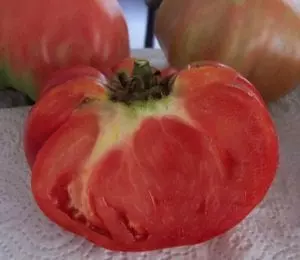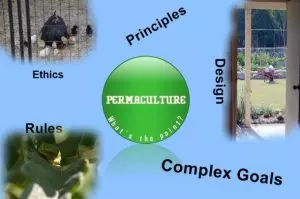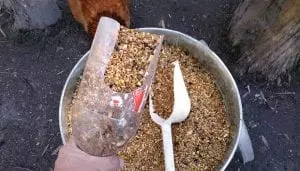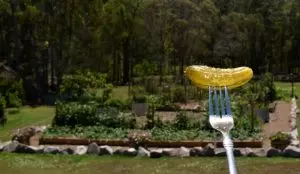This article was edited on 29th Dec 2016. Raised vegetable garden beds are a great way to garden but what is the best way to fill them with soil and how much (if any) drainage should be used? A little while back, I wrote about different types of raised garden beds so this post can be seen as a follow up to that article and hopefully it can answer some raised bed gardening questions with respect to filling them up.
This post will also touch on the types of drainage to use in a raised garden bed and also the best types of soil to use. A raised garden bed is generally quite a commitment and it’s something that once done can’t easily be moved or re-done so it really pays to make sure it’s done right the first time!
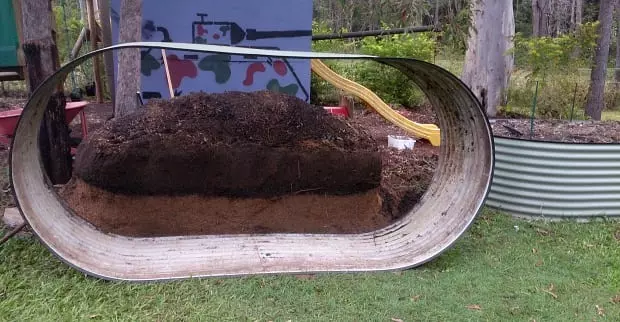
A raised garden bed removed exposing the soil and drainage layers (image above)
Why use drainage in a raised garden bed?
We all know drainage material allows water to run away rather than sit and pool. There are two main reasons why drainage should be used in raised garden beds and they are: to prevent waterlogging, and to save good soil.
A raised garden bed is just like one huge pot plant and if the bed doesn’t have any drainage it can become an anaerobic environment in heavy or prolonged rain making it very difficult for plants roots to breathe.
Secondly, good garden soil can be expensive and if you make your own it’s too valuable to waste at the bottom of a raised garden bed where it will never get used by food crops. Therefore, this fill is best done with cheap drainage material rather than good soil.
Do all raised beds require drainage?
The first thing to determine when filling a raised garden bed is does it really need drainage at all? And, my rule of thumb for deciding whether to use drainage in a raised garden bed or not is if it’s about knee height or below no drainage is required (generally speaking – there are exceptions at the end of this article).
Most vegetables don’t have very long root systems especially if they are annuals, some perennials (like asparagus) do have longer roots and can reach a few feet down, but the vast majority only need about a foot or 30 centimetres (cm) of growing soil (and many food crops won’t even need that much).
However, to allow room for error and plenty of space to till the soil if need be I like to use about 40 cm (16 inches) of growing top soil in my standard vegetable raised garden beds. This means that most standard two sleeper high raised beds or commercial kit beds will NOT require drainage material because they will be knee height or under.
For most people, that is all you really need to know but for those (like me) who prefer the higher raised garden beds and love “stand-up gardening” they should keep reading on, otherwise, big mistakes can be made when filling raised garden beds, which will take unnecessary time and lots of effort to rectify.
How much drainage does a raised garden bed need?
Now that we know we need at least 40 cm of growing soil in a raised garden bed, we can use this rule to work out how much drainage a raised garden bed requires. For example, if a raised garden bed is 80 cm high and we know we should allow 40 cm of growing soil then that leaves 40 cm of space for drainage.
Calculating exactly how much drainage material you need to get from the landscaping supplies centre is simply a matter of working out the volume of your bed. This can be done by yourself, the landscaping supplies staff, or there are plenty of online tools available to calculate the volume of materials needed.
Once the bed is full, it will reduce over time as the soil settles so it’s just a matter of topping the bed up with organic matter and mulch. If you used drainage material, it may compact somewhat, however, it won’t reduce in size too much, certainly not as much as the top soil can and will reduce.

This is an example of an 80 cm raised garden bed with approx 40 cms of drainage fill (image above)
Types of drainage
There are lots of different materials one can use as drainage in a raised garden bed but in my opinion some are better than others. I prefer to use a crushed granite (or anything similar) because it’s easy to handle, if it mixes a little with the top soil it doesn’t matter too much, it has excellent drainage properties, and it’s pretty cheap.
Sand is also OK but it should be washed or river sand to ensure it doesn’t contain too much salt because if it mixes with the top soil vegetable crops won’t grow very well at all!
Pebbles, bluestone, or any drainage rock/gravel can be used but top soil has a tendency to leach into the rocks and limit drainage effectiveness. Plus, moving these types of materials is much harder particularly by hand. I don’t like using drainage rocks for raised beds.
Other considerations effecting drainage
Floor base – If the raised garden bed has a base; that is, it is not opened to the ground then no matter how deep it’s a good idea to use some type of drainage material because it really is just one big pot. These types of raised beds usually come with drainage holes in the plastic base but they will quickly clog up unless drainage or something similar such as non-degrading shade cloth is used on the bottom to cover the outlets whilst still allowing water to seep through.
Raised bed situated on a water repellent surface – If the raised bed is positioned on a surface which does not readily drain (like concrete), then again, no matter the size, drainage needs to be incorporated in the overall planning otherwise the bed will simply fill with water. That is, assuming the seal around the base of the raised bed is flush on the concrete surface otherwise the water will likely seep out anyway, in which case drainage may not be the problem but a dirty mess on the surrounding concrete might.
Fill – Some people recommend throwing things like logs, large rocks, and old pots in the bottom of a raised garden bed to use as “fill” so less soil and drainage is required. I would be careful about doing this because it can affect drainage and also become a real hassle if the bed ever needs to be moved in the future.
That being said, I have used organic materials such as logs, wood scraps, leaves, and even general garden waste, in the base of several raised beds (instead of crushed granite or rock based drainage) with excellent results!
If the high raised bed (say 2-3 feet) has an open base and is situated on the ground then poor drainage is unlikely to be a problem, unless you fill the bed with very heavy soil of course…
Video
Below is a video about how much drainage and soil to use when filling a raised garden bed. Although much of the information in this video is still relevant, I now prefer to use organic matter in the base of my raised beds rather than crushed granite or sand.
Conclusion
Raised bed gardening is becoming more popular and it’s especially good for older citizens or disabled people because there’s much less bending involved. However, they do take more effort to fill (initially) and raised beds can be more costly also.
Therefore, the worst thing that can happen is to amplify the effort and cost by not correctly considering drainage in a raised garden bed at the beginning. Just like I stated in the video, allow about 30 – 40 cms of growing soil – anything under that, use drainage such as crushed granite (edit: or organic fill like logs, leaves, etc if the bed has an opened base and is positioned on the ground) and you won’t have any waterlogging problems.
If you would like to discuss raised bed gardening further, you can leave a short message below or better still join our forum www.selfsufficientculture.com and become a member of the best self-sufficiency forum in the universe.
Mark Valencia – Editor SSM
Look, and see the Earth through her eyes…



